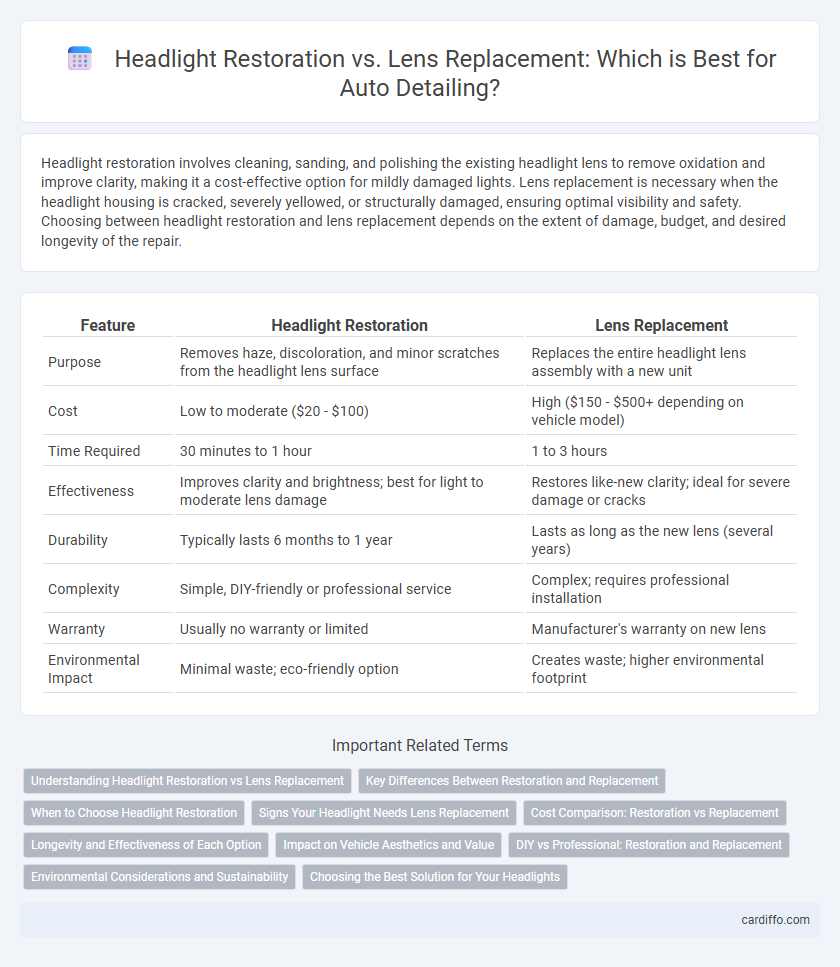Headlight restoration involves cleaning, sanding, and polishing the existing headlight lens to remove oxidation and improve clarity, making it a cost-effective option for mildly damaged lights. Lens replacement is necessary when the headlight housing is cracked, severely yellowed, or structurally damaged, ensuring optimal visibility and safety. Choosing between headlight restoration and lens replacement depends on the extent of damage, budget, and desired longevity of the repair.
Table of Comparison
| Feature | Headlight Restoration | Lens Replacement |
|---|---|---|
| Purpose | Removes haze, discoloration, and minor scratches from the headlight lens surface | Replaces the entire headlight lens assembly with a new unit |
| Cost | Low to moderate ($20 - $100) | High ($150 - $500+ depending on vehicle model) |
| Time Required | 30 minutes to 1 hour | 1 to 3 hours |
| Effectiveness | Improves clarity and brightness; best for light to moderate lens damage | Restores like-new clarity; ideal for severe damage or cracks |
| Durability | Typically lasts 6 months to 1 year | Lasts as long as the new lens (several years) |
| Complexity | Simple, DIY-friendly or professional service | Complex; requires professional installation |
| Warranty | Usually no warranty or limited | Manufacturer's warranty on new lens |
| Environmental Impact | Minimal waste; eco-friendly option | Creates waste; higher environmental footprint |
Understanding Headlight Restoration vs Lens Replacement
Headlight restoration involves cleaning and polishing the existing lens to remove oxidation and improve clarity, making it a cost-effective solution for mildly damaged headlights. Lens replacement is necessary when the headlight housing is cracked, severely damaged, or when restoration fails to restore adequate brightness, ensuring optimal light output and safety. Choosing between restoration and replacement depends on the extent of lens damage, with restoration suitable for surface wear and replacement required for structural issues or persistent cloudiness.
Key Differences Between Restoration and Replacement
Headlight restoration involves cleaning and polishing the existing lens to remove oxidation and minor scratches, improving clarity and light output at a lower cost. Lens replacement entails installing a new headlight assembly, eliminating severe damage, cracks, or deep scratches that restoration cannot fix. Restoration is ideal for cosmetic improvements, while replacement ensures structural integrity and optimal functionality.
When to Choose Headlight Restoration
Headlight restoration is ideal when headlights exhibit cloudy or yellowed lenses due to oxidation, as it effectively removes surface damage and improves light output without the cost of replacement. This method is most suitable if the headlight housing remains structurally intact and there are no cracks or severe damage compromising the lens integrity. Opt for restoration to extend headlight lifespan, enhance nighttime visibility, and save on the higher expense of new lens replacements.
Signs Your Headlight Needs Lens Replacement
Cloudy, cracked, or severely yellowed headlights indicate the need for lens replacement rather than simple restoration. Persistent moisture or fogging inside the headlight housing signals compromised seals, necessitating lens replacement to ensure proper function. Diminished light output despite polishing efforts marks irreversible damage, making lens replacement essential for safety and visibility.
Cost Comparison: Restoration vs Replacement
Headlight restoration offers a cost-effective solution, typically ranging from $50 to $150, compared to lens replacement, which can cost between $200 and $700 per headlight depending on vehicle make and model. Restoration extends the lifespan of existing lenses by removing oxidation and yellowing, avoiding the higher expenses tied to purchasing and installing new headlights. Opting for restoration not only saves money but also preserves original headlight quality when severe damage or cracks are absent.
Longevity and Effectiveness of Each Option
Headlight restoration typically improves clarity by removing oxidation and minor scratches, extending headlight life for 6 to 12 months, making it a cost-effective and eco-friendly solution. Lens replacement offers a longer-lasting fix, often restoring headlights to near-new condition with durability of several years, but at a higher price point and with more labor involved. Effectiveness depends on the headlight's condition; restoration suits lightly damaged lenses, while replacement is best for severely cracked or yellowed headlights to ensure optimal visibility and safety.
Impact on Vehicle Aesthetics and Value
Headlight restoration enhances vehicle aesthetics by removing oxidation and improving clarity, thus restoring the original brightness and sharpness, which can significantly increase the vehicle's resale value and curb appeal. Lens replacement offers a more permanent solution for severely damaged or cracked headlights, maintaining the integrity and appearance of the vehicle while preventing further damage that could depreciate value. Choosing between restoration and replacement depends on headlight condition, with restoration typically being cost-effective for minor wear and replacement necessary for structural damage to safeguard both aesthetics and investment.
DIY vs Professional: Restoration and Replacement
Headlight restoration involves polishing and sanding the existing lens to remove oxidation, a cost-effective DIY option that prolongs visibility and aesthetics without the need for full replacement. Lens replacement, typically a professional service, provides definitive clarity by installing new headlights, especially when damage or deep scratches compromise safety and performance. Choosing restoration saves money and time for mild wear, while replacement ensures long-term durability and optimal light output for severely deteriorated lenses.
Environmental Considerations and Sustainability
Headlight restoration minimizes environmental impact by reducing plastic waste and the demand for new parts, promoting sustainability through reuse and conservation of resources. Lens replacement often involves discarding old components, contributing to landfill buildup and increased manufacturing emissions. Choosing restoration supports eco-friendly practices by extending the lifespan of existing headlights and lowering overall carbon footprints.
Choosing the Best Solution for Your Headlights
Headlight restoration is a cost-effective method that removes oxidation and yellowing, improving light clarity and extending the lifespan of your existing lenses. Lens replacement involves installing new headlight covers, which is more expensive but necessary when lenses are severely cracked, faded, or structurally damaged. Choosing the best solution depends on the headlight's current condition, budget constraints, and desired longevity; restoration suits minor wear, while replacement ensures maximum performance for heavily damaged headlights.
Headlight Restoration vs Lens Replacement Infographic

 cardiffo.com
cardiffo.com